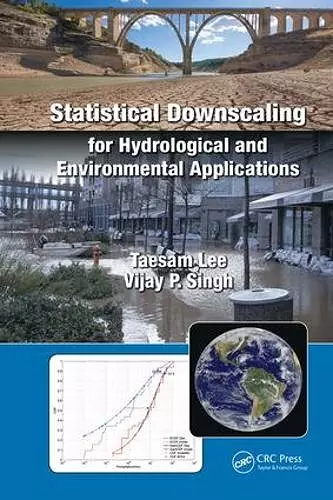Statistical Downscaling for Hydrological and Environmental Applications
Vijay P Singh author Taesam Lee author
Format:Hardback
Publisher:Taylor & Francis Ltd
Published:27th Sep '18
Currently unavailable, and unfortunately no date known when it will be back

Global climate change is typically understood and modeled using global climate models (GCMs), but the outputs of these models in terms of hydrological variables are only available on coarse or large spatial and time scales, while finer spatial and temporal resolutions are needed to reliably assess the hydro-environmental impacts of climate change. To reliably obtain the required resolutions of hydrological variables, statistical downscaling is typically employed. Statistical Downscaling for Hydrological and Environmental Applications presents statistical downscaling techniques in a practical manner so that both students and practitioners can readily utilize them. Numerous methods are presented, and all are illustrated with practical examples. The book is written so that no prior background in statistics is needed, and it will be useful to graduate students, college faculty, and researchers in hydrology, hydroclimatology, agricultural and environmental sciences, and watershed management. It will also be of interest to environmental policymakers at the local, state, and national levels, as well as readers interested in climate change and its related hydrologic impacts.
Features:
- Examines how to model hydrological events such as extreme rainfall, floods, and droughts at the local, watershed level.
- Explains how to properly correct for significant biases with the observational data normally found in current Global Climate Models (GCMs).
- Presents temporal downscaling from daily to hourly with a nonparametric approach.
- Discusses the myriad effects of climate change on hydrological processes. <
Statistical downscaling helps to obtain the required resolutions of hydrological variables. The book of Taesam Lee and Vijay P. Singh fills an important gap as to my knowledge no dedicated treatises on this particular topic are available so far.
I find this book especially helpful for hydrological modelers who want to examine how to handle the scaling of hydrological events such as extreme rainfall, floods, and droughts at the local, watershed level. In addition, honours-level undergraduates with a decent grounding in environmental science should find the material accessible, and modern in its coverage of topics such as how to properly correct for significant biases with the observational data normally found in current Global Climate Models (GCMs). Especially the numerous tables with example data help to apply the methods to simple exercises. However, for easier access to the practical examples the tables should have been made available online. With the diverse applications of statistical downscaling methods the readers´ awareness of these scaling techniques on environmental simulation results is raised. It will be useful to researchers in hydrology, hydroclimatology, agricultural and environmental sciences, and watershed management.
— Vadose Zone Journal, January 2019
Statistical downscaling helps to obtain the required resolutions of hydrological variables. The book of Taesam Lee and Vijay P. Singh fills an important gap as to my knowledge no dedicated treatises on this particular topic are available so far.
I find this book especially helpful for hydrological modelers who want to examine how to handle the scaling of hydrological events such as extreme rainfall, floods, and droughts at the local, watershed level. In addition, honours-level undergraduates with a decent grounding in environmental science should find the material accessible, and modern in its coverage of topics such as how to properly correct for significant biases with the observational data normally found in current Global Climate Models (GCMs). Especially the numerous tables with example data help to apply the methods to simple exercises. However, for easier access to the practical examples the tables should have been made available online. With the diverse applications of statistical downscaling methods the readers´ awareness of these scaling techniques on environmental simulation results is raised. It will be useful to researchers in hydrology, hydroclimatology, agricultural and environmental sciences, and watershed management.
— Vadose Zone Journal, January 2019
ISBN: 9781138625969
Dimensions: unknown
Weight: 416g
182 pages